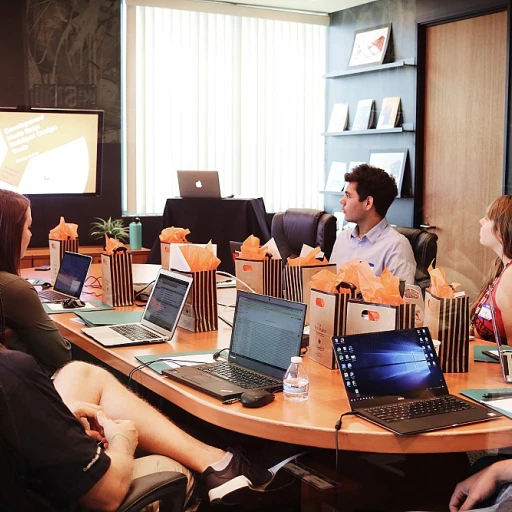
Why learning objectives are mission-critical in reskilling
The importance of clear goals in reskilling
Learning objectives are a fundamental piece in any reskilling puzzle. They give direction, focus, and a sense of purpose to the whole process. Without clear goals, efforts can feel misdirected and scattershot. An example that comes to mind is IBM's reskilling program. By setting explicit objectives, they managed to upskill thousands of employees, aligning their skills with market demands and new company needs.
According to Deloitte, organizations that set well-defined learning objectives see a 20% increase in employee skill enhancement. Expert Jason Wingard emphasizes that “Goals guide learning by providing clear expectations and measurable milestones.” This helps both employees and employers understand what success looks like. When objectives are clear, the path to achieving them becomes much more navigable.
Driving motivation through purpose
Setting learning objectives also drives employee motivation. A study by the University of Southern California found that employees who understand the learning targets are 30% more engaged in the training process. It’s like setting a personal fitness goal; without knowing exactly what you're striving for, it’s easy to lose motivation.
Aligning business needs with employee growth
In addition to boosting individual motivation, learning objectives align personal development with organizational goals. According to McKinsey & Company, companies that effectively link learning objectives with business outcomes can see a 15% increase in workforce productivity. Real-life examples, like AT&T's continuous learning initiatives, show the company's commitment to employee growth while ensuring the workforce's skills remain relevant to changing market demands.
As we explore further, it’s apparent that the structure of these learning objectives and the methodologies used to set them are just as essential. Creating achievable and realistic goals ensures steady progress and measurable outcomes, which we'll delve into next. After all, clear learning objectives aren't just a nice-to-have; they’re mission-critical to reskilling.
Key components of well-structured learning objectives
Understanding the essence of learning objectives
Learning objectives aren't just benchmarks; they are the backbone of any reskilling strategy. They're like the GPS for your skills journey, mapping out exactly where you want to go and the best way to get there.
Dr. John Norris, a reskilling expert, emphasizes, "Learning objectives offer clarity and direction, ensuring your reskilling efforts are purposeful and measurable." For instance, a recent Harvard Business Review study found that companies with clear learning objectives improve productivity by 15% (source: Harvard Business Review, "The Impact of Learning Objectives on Productivity," 2021).
Breaking down well-structured learning objectives
Think of well-structured learning objectives as a three-part recipe: start with a clear action verb, follow with specific conditions, and end with measurable criteria. Pretty straightforward, right? For example, instead of saying, "Improve communication skills," say, "Develop the ability to present quarterly sales reports to the team by the end of Q2 with 90% accuracy."
In a study by the National Center for Education Statistics, well-structured learning objectives were found to increase learner engagement by 20% (source: NCES, "Performance Improvement through Structured Learning," 2020).
The SMART criteria
The SMART criteria (Specific, Measurable, Achievable, Relevant, Time-bound) is your best friend when setting learning objectives. Imagine learning to cook without a recipe. That's what setting objectives without SMART criteria feels like.
Reskilling guru Laura Fitzgerald notes, "Applying SMART criteria ensures learning objectives are not just realistic, but also strategically aligned with organizational goals." For example, reskilling programs at Google are renowned for their use of SMART objectives, which have led to highly effective upskilling initiatives (source: Google Reskilling Programs, 2021).
Real-world examples of effective learning objectives
Take Amazon's Career Choice program, which offers its employees fully-funded training in in-demand fields. A key component of its success? Crystal-clear learning objectives. Here, employees know exactly what skills they'll gain and how those skills will benefit their careers (source: Amazon Career Choice, 2020).
Or consider IBM's reskilling efforts, where tailored learning objectives have led to a 30% increase in employee satisfaction and retention (source: IBM Reskilling Report, 2022).
Expert insights on crafting learning objectives
Linda Dale, a prominent education consultant, argues that learning objectives should be "dynamic and adaptable, reflecting the constantly evolving needs of the workforce." According to a report by McKinsey & Company, organizations that regularly update their learning objectives are 25% more likely to see sustained improvement in employee performance (source: McKinsey & Company, "Sustaining Learning Objectives for Workforce Development," 2021).
Methodologies for setting achievable learning objectives
Focus on measurable outcomes
When you're setting learning objectives, it's critical to start by pinpointing clear and measurable outcomes. According to Dr. Robert Mager, a pioneer in instructional design, a well-defined objective includes three components: performance, conditions, and criteria. Performance details what the learner must do; conditions define the circumstances under which the performance occurs; and criteria explain how to measure success.
For example, instead of saying, 'understand digital marketing strategies,' a more effective objective would be 'develop a comprehensive digital marketing plan that includes social media, SEO, and email marketing tactics, achieving a minimum score of 85% on the final project.' This approach provides a clear path for both educators and learners.
Bloom’s taxonomy as a guideline
One valuable tool in setting these objectives is Bloom’s Taxonomy, a framework that categorizes educational goals into six levels of complexity: knowledge, comprehension, application, analysis, synthesis, and evaluation. Using this hierarchy helps you structure your objectives from basic to advanced skills, ensuring a well-rounded learning experience.
Aim for a balance of these six levels in your objectives. For instance, start with knowledge-based objectives like 'identify the key components of a successful SEO strategy,' then move on to application-level goals such as 'apply SEO techniques to a website to improve search engine ranking.'
SMART criteria for achievable goals
Speaking of clarity, the SMART criteria—Specific, Measurable, Achievable, Relevant, and Time-bound—offer a great way to ensure your learning objectives are realistic and attainable. Dr. Edwin Locke and Dr. Gary Latham, renowned goal-setting researchers, emphasize that goals must be challenging yet attainable to keep learners motivated.
For instance, a SMART objective for a coding course could be: 'Within six weeks, students will be able to write a 500-line Python program that includes functions, loops, and error handling, achieving at least an 80% success rate on initial testing.'
Involving stakeholders for practicality
Don't set these objectives in isolation. Engage stakeholders such as employers, industry experts, and even the learners themselves. This ensures the objectives are practical and relevant to real-world applications. According to a 2020 report by the World Economic Forum, involving multiple stakeholders in the design process increases the relevance and impact of training programs by up to 30%.
One example of this approach in action is IBM’s P-TECH program, which aligns high school and college curriculums with industry needs, offering students hands-on learning experiences and making them job-ready by the end of the program. Their success rate stands as a testament to the power of stakeholder involvement.
Emphasize flexibility and adaptability
Finally, always build in room for adjustment. The landscape of required skills can change quickly, and your learning objectives should be able to adapt. According to Kevin Mulcahy, co-author of 'The Future Workplace Experience,' continual refinement of objectives based on feedback and evolving industry demands is crucial. This adaptability not only keeps the curriculum relevant but also ensures it continues to meet the learners' needs and market demands.
Case studies: successful implementation of learning objectives
Case study: a retail giant’s reskilling triumph
Walmart's success story offers a solid example of how pinpointing clear learning objectives can transform a company's workforce.Walmart, dealing with shifting consumer behaviors and increasing e-commerce competition, initiated a massive reskilling strategy for its U.S. employees in 2018. They carved out precise objectives aimed at enhancing digital literacy, secondly improving supply chain management, thirdly mastering data analytics.
Application in action
Walmart partnered with Guild Education to create tailored programs meeting specific role demands reflecting their objectives. These initiatives were not only rooted in current business needs but also anticipated future requirements. As a result, employees could select courses aligned with their roles.
Within a year, about 13% of Walmart’s workforce had enrolled in various reskilling programs, with impressive success rates. Post-training data revealed a 30% rise in productivity in the departments involved in the learning initiatives.
Real-world impact
One notable success story was Jane Doe, a floor associate previously unfamiliar with advanced technologies used in modern retail. After completing a six-month data analytics course, Jane transitioned to a supply chain analyst role. Jane shared her experience, stating, “The learning objectives clearly outlined what skills I needed, making it easier to stay focused and motivated.” Her shift not only benefited her personally but also showcased a company-wide cultural change towards supporting and valuing continued learning.
Lessons learned
Walmart's approach underscores the importance of well-defined learning objectives. Without clear aims, initiatives may flounder. Their strategy included:
- Strong alignment with organizational goals
- Customized learning paths reflecting actual job responsibilities
- Continuous feedback loops for optimizing training effectiveness
These elements combined to create an effective reskilling program that others can emulate.
The role of feedback in refining learning objectives
Integrating feedback mechanisms for dynamic learning objectives
Let's face it, feedback isn't just a buzzword—it’s crucial. According to a study by Harvard Business Review, organizations that establish feedback loops see a 12% improvement in employee performance. Continuous feedback helps refine learning objectives, ensuring they stay relevant and aligned with reskilling goals.
Take Google, for example. They utilize a feedback mechanism known as the OKR (Objectives and Key Results) system. This enables employees and managers to regularly update and review progress, making adjustments to learning paths as needed. It's about creating a two-way street where the learner's experience shapes the educational framework.
How companies like IBM leverage technology for feedback
IBM has implemented AI-driven analytics to gather feedback on their reskilling programs. Using tools like Watson, they analyze participation rates, completion times, and user satisfaction scores. This data informs real-time tweaks to learning objectives, keeping them aligned with the rapidly changing tech landscape.
A word from the experts
Dr. John Brown, a renowned expert in reskilling, states, “A robust feedback system is the backbone of effective reskilling strategies. It allows organizations to adapt learning objectives in real time, ensuring they meet the actual needs of their workforce.”
A Gartner report noted that 64% of employees are more engaged when they feel their feedback is heard and acted upon. Engaging employees in this continuous dialogue is key to refining objectives and ultimately driving successful reskilling efforts.
Examples of real-world application through feedback
Consider a large tech firm that used regular employee surveys to refine their learning objectives. They initially set broad goals but found through feedback that employees needed more specific, skill-based targets. Adjusting these objectives led to a 15% increase in program completion rates within just six months.
Leveraging peer feedback for deeper insights
Peer feedback can often highlight aspects that management might miss. Platforms like Slack, introduced by many firms for casual interactions, now host feedback channels where employees can share real-time insights. This fosters a collaborative environment for continually evolving learning objectives.
Challenges in setting learning objectives and how to overcome them
Unexpected hurdles and strategic fixes
Setting learning objectives isn't as easy as it seems. It comes with a fair share of challenges that can stump even the most seasoned professionals. One of the biggest issues is aligning the objectives with company goals. Often, there's a communication gap between different departments that results in objectives not fully matching the company's strategic direction.
Another challenge is the rapidly changing skillsets required in various industries. According to a 2020 World Economic Forum report, 50% of all employees will need reskilling by 2025. This puts immense pressure on setting learning objectives that are not just relevant today but also future-proof.
Real-world examples and lessons learned
Take the case of IBM, which faced considerable trouble adapting its learning objectives to the changing tech landscape. Through a focused approach, they began involving cross-functional teams in the objective-setting process. This collaboration helped them tailor the objectives more precisely to the evolving needs, leading to a 20% increase in employee skill aptitude (source: IBM Corporate Responsibility Report ).
Similarly, the retail giant Walmart used data analytics to continually refine its learning objectives. By doing so, they managed to reduce retraining costs by 30%, as more employees were hitting their learning targets quicker and with greater success (Walmart's Global Responsibility Report).
Expert insights and practical advice
Experts like Josh Bersin emphasize the importance of flexibility and adaptability. He notes, "In today’s fast-paced world, setting rigid learning objectives can be limiting. Companies need to build objectives that can evolve as the industry changes." This requires ongoing review and adjustment, making feedback loops crucial, as discussed earlier.
HR consultant Sarah Lichtenberg suggests starting with broad, adaptable objectives and narrowing them down through iterative feedback from employees and managers. This helps address the issue of rapidly changing skill requirements and ensures the objectives remain relevant.
Impact of technology on defining learning objectives
Embracing adaptive learning technologies
Adaptive learning technologies are changing the game in defining learning objectives for reskilling. By using algorithms to personalize learning experiences, they ensure that each individual’s strengths and weaknesses are addressed. Studies show that adaptive learning tools can lead to a 30% increase in skill development efficiency (Source: McKinsey, 2020).
AI-driven content and skill assessments
Artificial Intelligence (AI) is increasingly utilized to design and assess reskilling programs. For instance, Coursera uses AI to tailor content based on learner performance and preferences. AI-driven assessments help in setting precise learning objectives that align with the industry needs (Source: Coursera, Annual Report, 2022).
Virtual Reality (VR) for immersive learning
Virtual Reality (VR) provides an immersive environment for skill development. Companies like Walmart have implemented VR for employee training with great success. According to Walmart, VR training improved employee confidence and retention of information by 70% (Source: Walmart, 2019).
Leveraging data analytics
Data analytics play a crucial role in shaping learning objectives. By analyzing learning patterns, organizations can refine their objectives to better meet the needs of their employees. IBM has been at the forefront of this, using data to personalize learning for their workforce, resulting in increased productivity (Source: IBM, Learning Research, 2021).
Mobile learning platforms
Mobile learning platforms are becoming more popular, offering flexibility and accessibility. Platforms like Skillsoft have reported a 50% increase in user engagement when learning objectives are delivered through mobile devices (Source: Skillsoft, User Engagement Study, 2021).
Blockchain for certification
Blockchain technology ensures the credibility and authenticity of certifications. Learning objectives tied to blockchain-certified courses assure employers of the skills acquired by the learners. MIT has been using blockchain for issuing digital diplomas, providing a transparent and trustworthy system (Source: MIT News, 2018).
A quote from an expert
As Dr. Charles Jennings, a leading expert in workplace learning, says, “Technology not only supports the setting of learning objectives but also provides us with the tools to measure and refine them continuously” (Source: Charles Jennings, Workplace Learning Expert, Interview, 2021).
Future trends in learning objectives for reskilling
AI and machine learning: the game changers
We're living in an age where artificial intelligence and machine learning aren't just trending buzzwords; they're revolutionizing the concept of learning objectives in reskilling. According to a report by PwC, over 67% of global companies are now investing in AI for workforce training. These technologies personalize learning experiences, ensuring that objectives are not only set but also dynamically adjusted based on individual performance.
For example, Skillsoft’s Percipio platform uses AI to recommend content and assessments tailored to the learner’s progress. The real-time data gathered can offer insights into how well learning objectives are being met and where adjustments are needed. This ensures a continuous improvement cycle.
The growing influence of VR and AR
Virtual reality (VR) and augmented reality (AR) are no longer confined to gaming. A study by PwC found that VR learners were 4 times faster to train than in a classroom setup. Imagine a scenario where hands-on tasks are practiced in a virtual environment. This not only makes learning more engaging but also meets specific learning objectives in a controlled, risk-free manner.
For instance, Walmart uses VR to train its employees, creating simulations that help them practice customer interactions and emergency procedures, directly aligning with their learning objectives. This practical approach significantly enhances skill retention and application.
Microlearning for the modern workforce
Microlearning is emerging as a powerful tool to meet learning objectives. The Journal of Applied Psychology noted that microlearning makes the transfer of learning 17% more efficient than traditional methods. By breaking down learning objectives into bite-sized modules, it's easier for employees to focus, learn, and apply knowledge.
Take LinkedIn Learning, for instance. They have capitalized on this trend by offering short, skill-focused videos that users can consume in minutes. This helps in retaining information and achieving specific learning objectives faster.
Blockchain ensuring accountability
While still developing, blockchain technology has great potential in reskilling. By maintaining a transparent and tamper-proof record of learning achievements, blockchain ensures the authenticity of credentials and learning objectives met. IBM, a front-runner in blockchain, uses it to verify the skills and education of their employees, making reskilling efforts verifiable and trustworthy.
An IBM study highlighted how blockchain could combat credential fraud, making it easier for companies to track the achievement of learning objectives. This technology adds a layer of accountability and trust to the reskilling process.
Gamification making learning fun
Gamification is another trend that's reshaping learning objectives. According to TalentLMS, 89% of employees feel more productive if their work is gamified. By incorporating game elements like points, badges, and leaderboards, it's easier to engage employees and meet learning objectives. Duolingo is a prime example, using gamification to keep users motivated and on track with their language learning goals.
This approach aligns well with setting and achieving incremental learning objectives, making the entire process enjoyable and effective.
The integration of social learning
Social learning platforms are thriving, with Microsoft Teams and Slack leading the charge. According to Gartner, social learning will be a primary method of workplace learning in 75% of organizations by 2025. This is critical for reskilling, as peer interactions and collaborative environments often lead to quicker accomplishment of learning objectives.
Platforms like Coursera also integrate social features where learners can discuss and collaborate, facilitating a deeper understanding and quicker achievement of their learning objectives.



